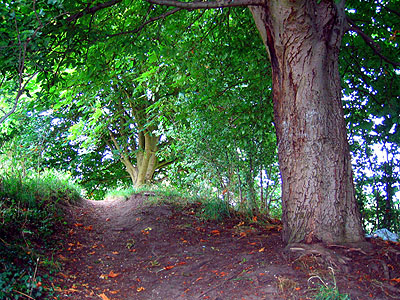The Burgh of Wallingford, Berkshire (original) (raw)
 The Burgh of Wallingford
The Burgh of Wallingford
Fortified Town of King Alfred
After regaining his kingdom from Viking invasion in AD 878, the Wantage-bornKing Alfred of Wessex established a long lasting peace for his people; and, to ensure they would always be safe from future attacks, he set up a system of defensive forts or 'burghs' across the country. Alfred gave permanent garrisons to his burghs, although many of them remained partly unoccupied for much of their early lives. Thus the monarch was able to exploit them as easily taxable trading centres or mints, as well as allowing for their more obvious role as places of refuge when the need arose. The second largest burgh in the country was at Wallingford in Berkshire and its ramparts remain as an impressive monument to the enterprise of the county's greatest son.
The settlement of Wallingford is first mentioned by name in a charter dated around AD 895. However, pre-10th century material dug up from across the town, and the irregular orientation of St. Leonard's Church, indicate that Saxons had been living at this important Thames crossing point for some years before Alfred's town-planners arrived. Located on a gravel terrace in a strategic position guarding the northern end of the Goring Gap, Wallingford had, in fact, probably been a focus of both road and water-borne communications since late Roman times.
It was around this small settlement that King Alfred had massive earthern rampart erected in a rectangle covering some forty-one hectares of land. Its lay-out was expanded over a formal street-grid system in the southern half, the most important routeway being the 'wall street' which allowed troops to move quickly along the ramparts. Wallingford required an astounding 2,400 men to fully defend it; so it is not surprising that almost one in five adult males in Wessex owed military service to the King upon request. The soldiers here were called therefore, not only from the permanent garrison, but from manors all over Berkshire and Oxfordshire: as shown by the rural manors with attached properties in the town that were recorded in the Domesday Book (1086). The first occupation of the fort may have been completely military in nature, but the population soon grew with the development of associated specialist craft industries. Furthermore, Alfred's successors - Edward_the Elder_, Athelstan and Canute - attached great importance to trade being carried out in a peaceful manner and before witnesses, only within a burgh under the supervision of a Royal official. Athelstan also decreed that mints should be established in burghs. As a result, Wallingford may have received its first moneyer, although the first evidence of Wallingford coinage comes from the reign of King Edgar the Peacemaker, just prior to his coinage reforms of AD 973. The urban functions and growth of the burgh was thus greatly encouraged and there may have been a significant redistribution of population from the countryside to these 'new towns'. By the late 10th century, Wallingford had certainly become the county town of Berkshire, and it remained the only mint in the area until Edward_the Confessor_'s reign.
The Domesday Book of 1086 tells us much about how the town had developed by the late Saxon period. With a population estimated at between two and three thousand, Wallingford heads the entries for Berkshire and is described totally separately. It still possessed its mint of course, and mention is made of a Saturday market, along with twenty-two Frenchmen - no doubt merchants - living there. Apart from trade, there was also manufacturing industry, indicated by the presence of a number of smiths, and the nature of the tenure generally was extremely varied. Contributory properties across the river and Royal carrying services to and from Blewbury,Reading, Sutton Courtenay and Benson show that, by this time, Wallingford had developed into a vast economic force, exercising influence on both sides of the Thames.
